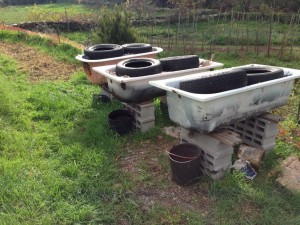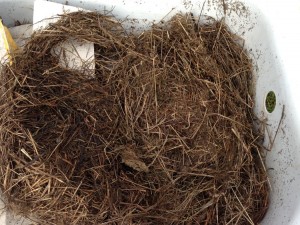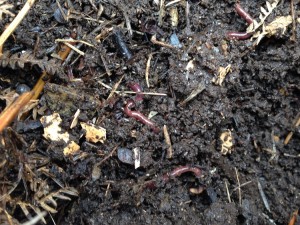This is part of a series of posts where we ask one of our volunteers or visitors to say a few words. Sam is in his second week here as a volunteer and has kindly allowed us to share his online thoughts. Here, Sam explores our vermicomposting system.
A Visitor’s Perspective: Sam’s Diary – Permaculture Vermiculture
As many of you already know, worm composting is a hobby of mine. Back home I have a worm bin filled with red worms where I put my vegetable scraps. My worms digest these scraps and poop out humus, a natural compost, which I eventually add to my garden soil. At Casalinho they practice vermiculture in a slightly different way. I call it permaculture vermiculture! Below is a picture of their three worm bins/old bath tubs.
An old bath tub seems like the perfect thing to convert into a worm bin, with it’s rectangular shape, strong walls used to hold the worms within, and a drain at the bottom to let water out. As you can see in the picture above, buckets are placed beneath each drain. This ‘worm water’ is caught and used as fertilizer for the gardens. I do the same thing with my worm water at home 🙂 On top of the tubs are old clothes and car tires. The clothes are there simply to protect the compost from the elements and the tires hold everything down. I was surprised at what I found under the clothes.
It didn’t look like any worm compost I’d seen before. It was just dried up leaves. This is where I found the main difference between my worm compost and the worm compost at Casalinho. Because all their food scraps already go to the goats and chickens they don’t put any scraps in their worm compost. They simply put in leaves from the surrounding forest. I didn’t even know this was possible. Essentially they are mimicking nature, where trees drop leaves on the ground that decompose and are eaten by worms. This transforms the leaves into humus which nutures the earth. This emulation of nature explains why Casalinho’s method of worm composting is ‘permaculture vermiculture’.
After digging past the first layer of leaves I found what I was looking for, dark rich humus crawling with red worms. Looks like vermiculture permaculture works wonderfully. I might just start adding some leaves in my worm compost at home.
You can see the original of Sam’s article, and read more about his adventures here.




Leave a Reply